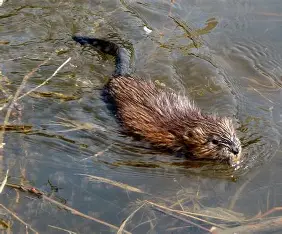by Onda Zibeth
Muskrats are much smaller than beavers and they have narrow tails. They spend most of their time in wetlands but, in spring, you can sometimes see them travelling on the pathways, in search of a new home or a mate. On land, they are vulnerable to local coyotes.
Muskrats need clean waters with aquatic plants to eat and willows or other waterside plants with which to build their floating lodges. Your best chance of seeing them is normally at dusk or dawn, when they are swimming and feeding.
Their glossy brown fur used to be popular for fur coats. Their musky smell is what led to their name. Muskrats typically weigh between 2.2 to 4.4 pounds, and their length, including the tail, ranges from 16 to 28 inches. The tail itself makes up about half of their total length.
Although they are herbivores, they have been known to eat freshwater snails or other small, bottom dwelling animals in winter, when plant food is scarce. While they do not hibernate, during extreme winter weather conditions, muskrats will stay in their underground dens or lodges where they cache their food.
Muskrat gestation is typically around 28 days, and females can have two to four litters per year, averaging six to eight young per litter. They typically live for two to four years in the wild. However, some may live up to twice as long.


Click here to the Bayview Community News home page for the latest Bayview community updates.
Click here to the Palliser Community News home page for the latest Palliser community updates.
Click here to the Pumphill Community News home page for the latest Pumphill community updates.











